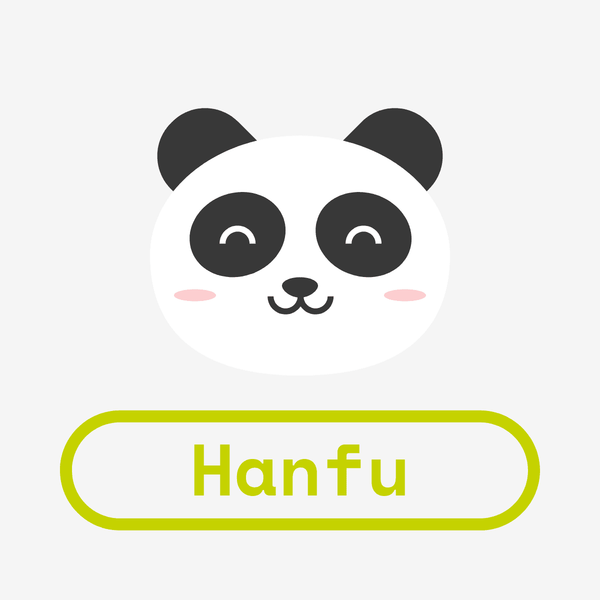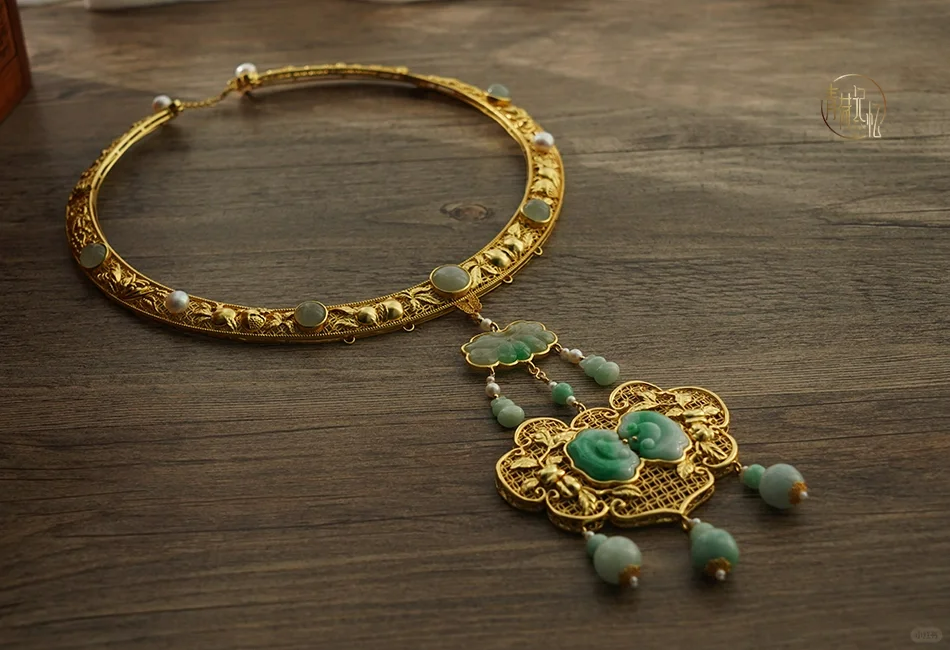1. Ruqun 襦裙
Ruqun is one of the most iconic styles of hanfu and one of the most popular for its flattering silhouette and is an excellent choice for newcomers to Hanfu as it's arguable one of the easiest styles to wear. The Ruqun has been worn throughout all Chinese Dynasties from even before the Han Dynasty, to the Late Qing.
It consists of a Ru 襦 (blouse or jacket) worn on top and a Qun 裙 (long skirt) worn on the bottom. The Ruqun of course went through many changes throughout Chinese history, however stays true to the simple formula of Ru 襦 Shirt + Qun 裙 Skirt.
(Poqun, Style of Ruqun during the WeiJin Dynasties, note the many layers of Ru!)
The Ru 襦 depending on the dynasty could be crossed collared, or open collared, tucked in or untucked. The sleeve width of the Ru 襦 varied as well, ranging from extremely wide sleeves of the Northern Southern Dynasties (420 AD - 589 AD) to the slimmest sleeves of the Sui Dynasty (581 AD - 618 AD).
The skirt styles and names also depended on the era, but were always long skirts. During the WeiJin Dynasties (220 AD - 420 AD), the Qun 裙 took on a wide A-line shape, made of wide strips of cloth pieced together to create a striped effect. This was called a Poqun 破裙 or "broken skirt". During the Song Dynasty (960 AD - 1279 AD), a slimmer skirt with a dizzying amount of pleats called Baidiequn 百迭裙 or "hundred pleat skirt" was popular to wear with the Ruqun combination.

(Baidiequn, Hundred Pleats Skirt, Song Dynasty)
Ruqun 襦裙 is known for its simplicity and versatility, making it suitable for various occasions, and definitely why it's one of the most popular styles of hanfu in recent and ancient times!
2. Qixiong Ruqun 齐胸襦裙
If you're a fan of the Tang Dynasty, this is probably the style you're most familiar with! This empire high style of dress originates from Northern Southern Dynasties (420 AD - 589 AD) gaining its well deserved time in the spotlight during the Tang Dynasty (618 AD - 907 AD). Unfortunately, the Qixiong Ruqun loses its popularity after the Early Song Dynasty (960 AD - 1279 AD), never to be seen again till the recent hanfu revival movement.
Following the same basic formula as the previous Ruqun 襦裙, Qixiong 齐胸 means "chest high" and refers to the skirt being tied over the bust. Thus, Qixiong Ruqun 齐胸襦裙, chest-high shirt-skirt combination.
During its popularity, the Ru 襦, more commonly called Shan 衫 during the Tang, ranged in collar styles and sleeve length and width. In the Sui, the Shan 衫 had rounded collars extremely skinny sleeves that went well past the hands (original sweater paws!).
Some forms of the Shan 衫 during the Wu Zhou Period (Empress Wu Zetian's reign, 690 AD - 705 AD) took on drastic "W" shaped cuts to reveal cleavage, a popular trend during the Empress's Rule. By the High and Late Tang, the Shan 衫 had a much deeper collar and wider sleeves that gave an air of elegance.
(Evolution of Tang fashion, from Early to Late)
The Qun 裙, went through much more of an amazing evolution. Starting in the Sui and Early Tang, these chest high skirts were made up of many strips of fabric, creating stunning striped patterns. Some of these early Qixiong Ruqun also had Shoulder straps, which I assume is a much missed aspect by the ladies of the later Tang. During the Middle and Late Tang, floral prints on skirts were favored as the dyeing capabilities of the flourishing empire drastically improved.
A common accessory you'll see with many Qixiong Ruqun outfits from the Sui, to sometimes in the Song Dynasty, was the Pibo 披帛. A long, decorative shawl draped over the shoulders, or around the elbow, or tucked into your skirt-- Wherever you wanted it to go! One of the most beautiful accessories in Chinese history, it never fails to give you an ethereal air of a goddess.
3. Aoqun 袄裙
Yet another Shirt + Skirt combination! But Aoqun 袄裙 typically refers to styles of shirt worn over the skirt, not tucked in, a popular style from the Late Song (960 AD - 1279 AD) to Ming Dynasty (1368 AD - 1644 AD).
During the Ming, the Aoqun 袄裙 was by far the most popular style of dress for both commoners and royalty alike. With the Ming Dynasty's now world renowned textiles and sewing capabilities, new styles of shirts emerged. With the advent of metallic buttons called Zimukou 子母扣, standing collar styles (by far the most iconic characteristic of Chinese clothing) became widespread. Standing collar shirts, called Liling Shan 立领衫 or Liling Ao 立领袄, were worn by almost every woman across China; a fashionable and modest shirt, reflective of the Ming's air of regality.

(Changshan Above)
Keep in mind, the Qun 裙 half of the Aoqun is different from the previous styles of Qixiong Ruqun and Ruqun!
Usually within the Ming Dynasty's Aoqun combination, the Qun is either a Baidiequn 百迭裙 (also called Baizhequn 百摺裙), "Hundred Pleats Skirt"; or the Mamianqun 马面裙, "Horse Face Skirt". Mamian 马面 are made with a thicker, brocaded fabric than the Baidiequn 百迭裙 which is usually a lighter, daily skirt.
(Mamian Skirt Above)
The designs of the Mamian 马面 range depending on the time period of the Ming Dynasty. During the earlier half of the Ming, when shorter styles of Ao 袄 were in style, the brocades on the skirts would rise all the way to the knees. During the later half, as longer styles of shirts with standing collars like Changshan 长衫 "Long Shirt" began to appear with the invention of metal buttons, the designs of the Mamian 马面 were reduced to floor-grazing decorative trims.
4. Shenyi 深衣
Shenyi 深衣 is a style of hanfu that worn during the earliest dynasties: Spring & Autumn Period, Warring States, Qin, and Han. The Shenyi was popular from 770 BC - 220 AD, and made a comeback in the later Song and Ming Dynasties' menswear, making it one of the longest standing forms of traditional dress in Chinese history!
The Shenyi 深衣 is typically a one-piece robe that wraps around the body once or multiple times, literally translating as "wrapping the body deep within the clothes". There were no undergarments during these early years so having that security and extra coverage was extremely important for both nobles and commoners alike. There are two main forms of Shenyi 深衣: Zhijupao 直裾袍 "straight hem robe", or Qujupao 曲裾袍 "curved hem robe". 
(Zhiju, straight hem robe)
These two versions of Shenyi were interchangeable between sexes as there were no strict emperor-made rules about womenswear and menswear during the earlier dynasties. Zhiju 直裾 remained mostly the same throughout its popularity in hanfu fashion, but Quju 曲裾 varied in amount of wraps around the body, ranging from multiple to a singular wrap. Both robes were fastened with a belt called Dai 带, and could either be made of magnificent brocades, or simple cloth depending on your wealth. As long as it held the robe closed!
(Quju, curved hem robe)
A fun accessory seen commonly with Zhiju 直裾 and Quju 曲裾 was the Jinbu 禁步 "waist ornament". Long, dangling charms that hung from the Dai 带 would make a charming twinkle noise as the wearer walked and helped keep the flaps of the Shenyi from flying up.
Depending on the material they were called different names, but the most popular style of Jinbu 禁步 for Shenyi hanfu is the Yupei 玉佩 "Jade Ornaments". Jade has long been an integral part of Chinese beliefs and beauty since ancient times (and still!) 
5. Yuanlingpao 圆领袍
Now for a popular unisex item in both ancient and modern times, the Yuanlingpao 圆领袍 is a delightfully comfortable round collared robe that reminds us of the sheer magnitude of the Silk Road; this garment is proof of foreign influences prevalent during Tang China (618 AD - 907 AD) including cultures from Gandhara, Sogdia, Turkestan, Persia and Greece.
Originally described as Hufu 胡服 or "foreign fashion", the Yuanlingpao 圆领袍 has become an integral part of historical fashion for not only China, but Korea, Japan, and Vietnam. 
(Common outfit for Tang men, yuanlingpao, futou, black boots and belt)
Although its origins can be traced back to the Han Dynasty (206 BC - 220 AD), the Yuanlingpao 圆领袍 was only worn as an inner undergarment. It is tied with a leather belt at the waist and commonly paired with black boots, and don't forget your hat! A variety of headwear was worn throughout the Tang Dynasty, but by the most popular was the Futou 幞头, a black rectangular cloth tied to the front and back of your head over a rounded hair cage.
Although this is typically a male attire from the Tang to Ming Dynasties, women during the Tang Dynasty considered it extremely fashionable to dress like the boys! Women loved to don the same round collared robe, boots, and belt and play polo or soccer just like the men did.
(Tang lady wearing yuanlingpao and with cute makeup!)
The Yuanlingpao 圆领袍 remained popular in both commoner and royalty closets until the Qing Dynasty but of course varied over the centuries. During the Song Dynasty (960 AD - 1279 AD), the Yuanlingpao took on a similar form with wider sleeves and during the Ming (1368 - 1644), the Yuanlingpao were decorated with large square patches called Buzi 补子to denote court status. 
You may discover and share more Hanfu at here:
www.shophanfu.com

